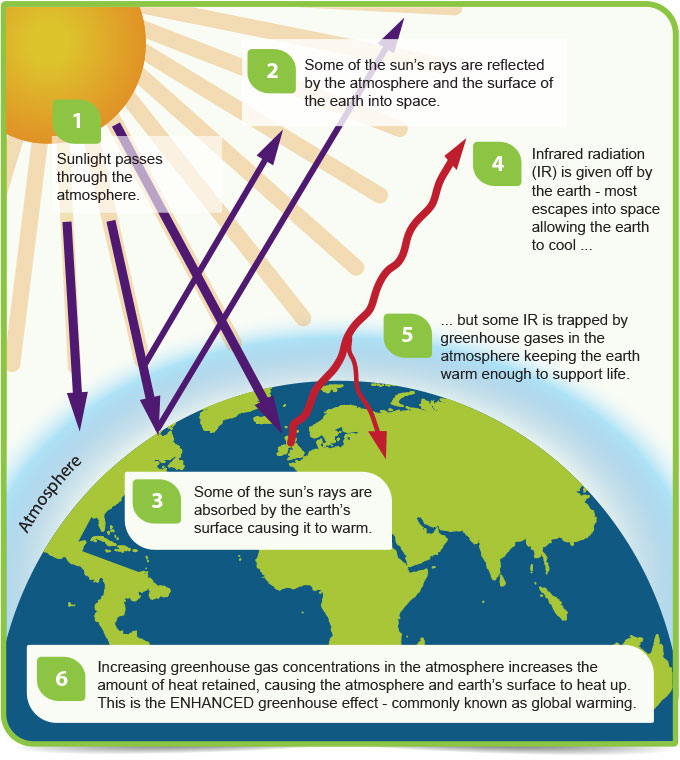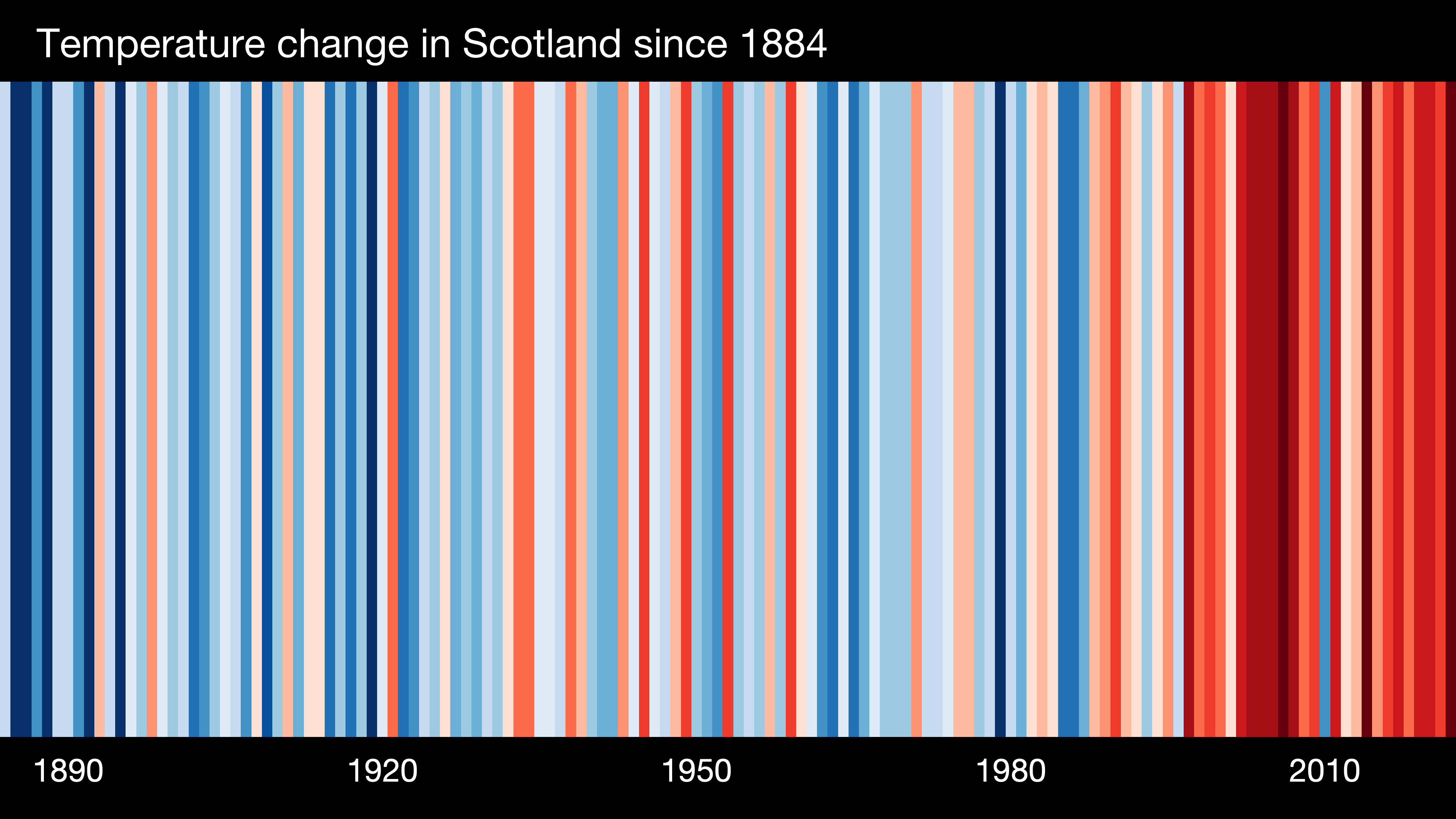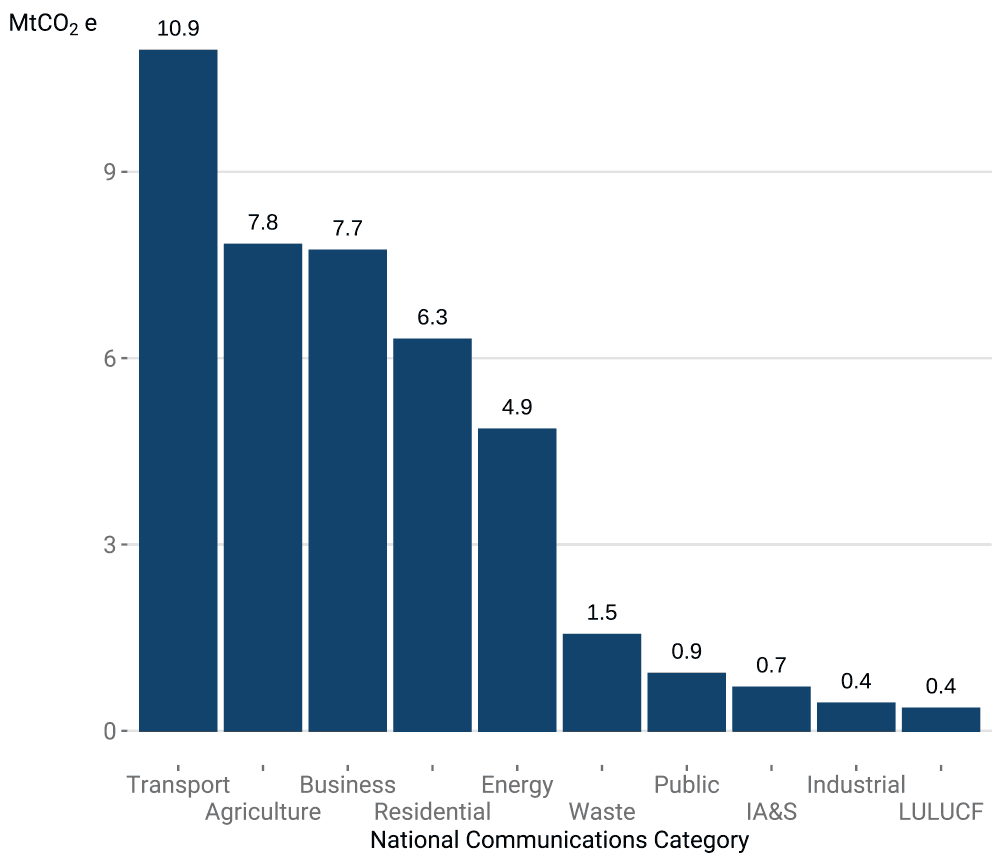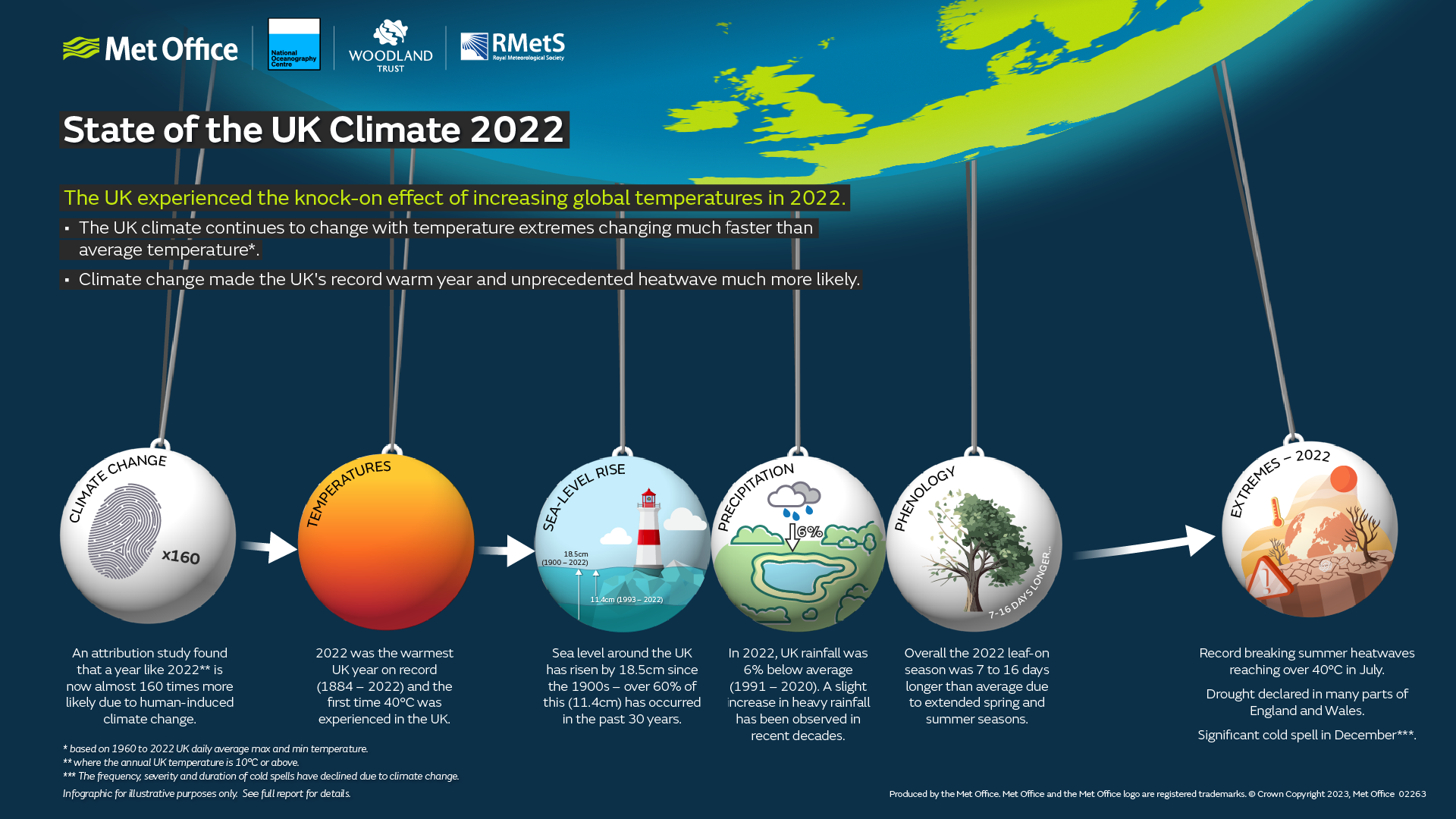Scotland generally has cool summers, mild winters and rainfall throughout the year. However, our climate is changing. Over the last few decades Scotland has experienced a warming trend and shifting rainfall patterns. In future, we expect to see warmer wetter winters and hotter drier summers with more extreme events. These changes will have major implications for our way of life.
Key messages
- The world's climate is changing. Since the late 1800s, the atmosphere and ocean have warmed, amounts of snow and ice have diminished, and sea level has risen as a result.
- There is overwhelming evidence that, since the mid-1800s, human activities have influenced global warming by releasing increasing amounts of greenhouse gases into the air.
- On a global scale, 2023 is set to be the warmest year on record and the past 9 years, 2015 - 2023, will be the 9 warmest on record. 2011 – 2020 was the warmest decade on record.
- The number of weather-related disasters around the world has increased over the last 50 years.
- Over the last few decades Scotland has also become warmer with shifting rainfall patterns, and rising sea levels.
- In future, the changes we are already experiencing both in Scotland and across the world are projected to intensify, with more extreme rainfall and associated flooding and more intense and frequent heatwaves.
- Some impacts of climate change on changes in global sea level and ice sheets are now effectively irreversible on a human timescale.
- The amount of change we see in future will depend on how successful we are in reducing global greenhouse gas emissions.
- The 2023 Climate Change Conference (COP28) reiterated the goal of the Paris agreement to limit global warming to 1.5 degrees Celsius, acknowledged this needed deep cuts in greenhouse gas emissions, and recognised that required a transition away from fossil fuels.
What is climate change?
Climate is the average weather (e.g. temperature, rainfall) taken over a long period of time. Climate change is the long-term shift in climate patterns.
We know from the geological record that there have been large variations in the Earth’s climate over thousands and millions of years. However, recent change is faster than anything seen before.
Watch: What is climate? Met Office climate change guide
Read: What is climate change?
What causes climate change?
The latest IPCC synthesis report published in March 2023, clearly states that human activities have caused global warming, with global surface temperatures increasing by 1.1 degrees Celsius in the last 150 years or so. This is already changing the climate in unprecedented and in some cases irreversible ways, damaging nature, people, communities and economies across the world.
This is driven by greenhouse gas emissions. These gases trap heat in the atmosphere, raising the Earth’s surface temperature. This is known as the Greenhouse effect.
The main greenhouse gases produced by both human and natural activities are:
- Water vapour (H2O)
- carbon dioxide (CO2)
- nitrous oxide (N2O)
- methane (CH4)
- ozone (O3).
There are also some entirely human-made greenhouse gases in the atmosphere, including sulphur hexafluoride (SF6), hydrofluorocarbons (HFCs) and perfluorocarbons (PFCs).
The key sources of greenhouse gases globally are:
- Burning fossil fuels
- Deforestation
- Agriculture
- Cement production.
Natural cycles such as changes in the strength of the sun and the orbit of the earth as well as volcanic eruptions affect the temperature of the earth. However, the rapid change in climate seen over the last 250 years cannot be explained by these natural cycles alone but can be explained by a combination of natural and human-made impacts.
In 2022, observed concentrations of the three main greenhouse gases (CO2, CH4 and N2O) in the atmosphere and oceansreached new highs. Real time data from specific locations show this increase continued into 2023.
Watch: What is the greenhouse effect?
Global Climate Change
The Intergovernmental Panel on Climate Change (IPCC) report Climate Change 2021: The physical science basis confirms that since the late 19th century the atmosphere and oceans have warmed, amounts of snow and ice have diminished, the sea level has risen, and concentrations of greenhouse gases in the atmosphere have increased.
- The increase in greenhouse gas concentrations since around 1750 are unequivocally caused by human activities.
- Each of the last four decades has been successively warmer than any decade that preceded it since 1850.
- The scale of recent changes is unprecedented in at least the last 2000 years.
The data behind the figures in the report can be accessed from the IPPC dataset collection.
A regional fact sheet showing the changes expected in Europe is available.
The report shows that emissions of greenhouse gases from human activities are responsible for approximately 1.1°C of warming since 1850-1900, and finds that averaged over the next 20 years, global temperature is expected to reach or exceed 1.5°C of warming.
The report finds that unless there are immediate, rapid and large-scale reductions in greenhouse gas emissions, limiting warming to close to 1.5°C or even 2°C will be beyond reach.
For 1.5°C of global warming, there will be increasing heat waves, longer warm seasons and shorter cold seasons. At 2°C of global warming, heat extremes would more often reach critical tolerance thresholds for agriculture and health, the report shows.
More information on the status of key climate indicators in Europe can be found in the State of the Climate in Europe 2022 report.
How has Scotland's climate changed?
Over the last few decades Scotland has experienced a warming trend, shifting rainfall patterns, and rising sea levels:
- Scotland’s 10 warmest years on record have all occurred since 1997. The average temperature in the last decade (2010-2019) was around 0.7°C warmer than the 1961-1990 average.
- There has been an increase in rainfall over Scotland in the past few decades, with an increasing proportion coming from heavy rainfall events. The average year in the last decade (2010-2019) was 9 % wetter than the 1961-1990 average.
- Average sea level around the UK has risen by approximately 1.4 mm/year since the start of the 20th century.
Temperature Change in Scotland 1884 - 2022
Click on the image to view a larger version.
How will Scotland’s climate change in future?
The changes in climate that we are already experiencing are projected to continue and intensify:
- Average temperatures will increase across all seasons
- Typical summers will be warmer and drier
- Typical winters will be milder and wetter
- Intense, heavy rainfall events will increase in both winter and summer
- Sea levels will rise
- Reduced frost and snowfall
- Weather will remain variable and may become more variable.
Recent analysis has discovered that Scotland’s climate is changing faster than scientists previously predicted, with increasing likelihood of more frequent and more extreme weather events. Weather patterns in Scotland were found to have changed substantially since 1960 and changes that were expected to be seen over the next three decades are already happening.
Impacts of climate change
Some impacts of climate change on global sea level and ice sheets are now effectively irreversible on a human timescale.
- The rate of sea level rise has doubled since 1993, reaching a new record high in 2023, reflecting continued ocean warming as well as melting glaciers and ice sheets.
- Antarctic sea ice extent reached a record low in February 2023 (since satellite records began in 1979).
- In 2023, glaciers in western North America and the European Alps had an extreme melt season. Swiss glaciers lost around 10 % of their remaining volume in the last 2 years.
2021 saw record breaking heatwaves, devastating wildfires and flooding events across the globe. This pattern persisted in 2022.
Extreme weather and climate events continued to have major impacts across the world in 2023, affecting water and food security as well as people’s health and well-being.
- Flooding associated with extreme rainfall from cyclones affected many parts of the world, including Libya, Bangladesh, Myanmar and southeast Africa.
- Extreme heat also affected many parts of the world; some of the most significant heatwaves were in southern Europe and north Africa.
- Long term drought persisted in northwest Africa and parts of the Iberian Peninsula as well as parts of central and southwest Asia.
- Drought intensified in parts of Central America, South America and southern USA.
- Wildfires in Hawaii, Canada and Europe led to loss of life, the destruction of homes and large-scale air pollution.
The WMO updated its Atlas of Mortality and Economic Losses from Weather, Climate and Water-related hazards in 2023. The key findings are summarised in a storyboard.
More information on the impacts of climate change in Europe can be found in the State of Climate in Europe 2022 report and storyboard.
Impacts of climate change in Scotland include increases in flood risk, coastal change, damage to buildings and infrastructure, and increased prevalence of pests and diseases in the natural environment.
Recent research on the potential impacts of climate change on Scotland’s Natural Capital warns that increased water scarcity could impact food production, damage the ecology of our rivers and undermine efforts to restore peatlands, while increasing winter rainfall could increase the risk of flooding. The trends of increased warming and reduced rainfall in the spring and summer will also increase wildfire risk.
2023 was a year of extremes in Scotland, with a significant water scarcity situation developing in some areas in June while extreme rainfall events caused flooding and landslides in October.
Hundreds of homes were flooded, roads were closed, rail services were disrupted, and millions of pounds of crops were lost.
The Met office in collaboration with the BBC have created a climate change visualisation tool where you can find out more about climate change in your local area.
Climate change is also a key driver of the nature emergency - it is the single greatest threat to Scotland’s habitats, whether they’re found on our mountain tops or our sea beds. Some habitats will be directly affected. More often, climate change will alter the intricate ecological balances that let plants and animals grow and thrive.
Scottish greenhouse gas emissions
Scotland has made significant cuts in greenhouse gas emissions; they have nearly halved since 1990.
In 2021, Scottish greenhouse gas emissions were estimated to be 41.6 million tonnes carbon dioxide equivalent (MtCO2e). This is 1 MtCO2e more than 2020 (a 2.4 % increase), and 40.3 MtCO2e less than 1990 (a 49.2 % reduction).
The main contributor to the increase in emissions between 2020 and 2021 was domestic transport (+1.1 MtCO2e) following the impact of the COVID lockdown in 2020.
Since 1990, the energy supply sector has contributed most to the overall reduction (77.6 %) as coal fired power stations have closed and renewable energy generation has increased. The top 3 emitters now are domestic transport, agriculture, and business.
In 2021, carbon dioxide was the largest contributor to Scottish greenhouse gas emissions (66.0 %) followed by methane and nitrous oxide. Domestic transport was the biggest source of CO2 emissions while agriculture was the main source of methane and nitrous oxide emissions.
For more information see: statistics 2021
Diagram: Sources of Scottish Greenhouse Gas Emissions 2021. Values in MtCO2e. (statistics: 2021)
Click on diagram to view a larger version.
Data
Data is being collected to assess changes in climate and measure greenhouse gas emissions and identify sources and sinks.
Across the world, people are measuring the concentration of gases in the atmosphere as well as direct emissions and sinks of greenhouse gas. Others are measuring climate variables such as temperature and rainfall, and the impacts of these variables like changes in sea level and ice cover.
From satellites to ice cores, from weather stations to water samples, the huge body of evidence collected over many years reveals the signals of a changing climate and allows more sophisticated modelling. The understanding of the climate and how it is changing is increasing all the time.
The World Meteorological Organisation (WMO) maintains a data catalogue for global climate data.
You can access a range of UK climate datasets from the Met Office website.
Scotland’s Climate
Scotland generally has cool summers, mild winters and rainfall spread throughout the year. However, there are regional differences as well as differences between seasons.
The Met Office has separated Scotland into three climatic zones – Northern, Eastern and Western– describing the main features of each region’s climate.
Regional weather summaries and data download of the time-series monthly, seasonal and annual regional values are also available from the Met Office.
Scotland’s climate trends
A UK temperature, rainfall and sunshine time series dataset provides measurements of climate variables across the United Kingdom since 1884. You can also view data for Scotland.
Scottish climate projections
The 2018 UK Climate Projections, produced by the Met Office Hadley Centre, provide up-to-date information about the potential future climate in Scotland. Headline findings (PDF).
You can download and view UK Climate Projections data from the Met office website.
A series of factsheets providing an overview of results is also available
Scottish greenhouse gas emissions 2021
The Scottish Greenhouse Gas Inventory is the key tool for understanding the sources and magnitude of greenhouse gas emissions in Scotland. The latest figures available are from 2021. You can download the results of the greenhouse gas inventory.
State of climate reporting
The Met Office publishes an annual State of the UK Climate report, which summarises the UK weather and climate throughout the years. Key messages from the 2022 report are illustrated in a State of the UK Climate 2022: Summary infographic.
The WMO publishes annual statements on the status of the global climate to provide credible scientific information on climate and its variability. A provisional state of the global climate in 2023 is available. This explains the state of the global climate, how it is changing and the impacts this is having.
WMO also summarise the key points in a storyboard.
Watch - Provisional state of the global climate 2023.
A State of the Climate in Europe 2022 report and storyboard are also available.
What are we doing?
We need to reduce our greenhouse gas emissions to prevent further climate change. We also need to prepare for the climate change that we cannot avoid due to our previous emissions.
Monitoring climate
Scientists use observations from the ground, air and space, along with theoretical models, to monitor and study past, present and future climate change. Climate data records provide evidence of climate change key indicators, such as global land and ocean temperature increases; rising sea levels; ice loss at Earth’s poles and in mountain glaciers; frequency and severity changes in extreme weather such as hurricanes, heatwaves, wildfires, droughts, floods and precipitation; and cloud and vegetation cover changes.
All of this data and information is brought together by the IPCC working groups who summarise the understanding of the current state of the climate, including how it is changing and the role of human influence, the state of knowledge about possible climate futures, climate information relevant to regions and sectors, and limiting human-induced climate change.
This informs the international community.
International agreements
With 198 parties, the United Nations Framework Convention on Climate Change (UNFCCC) has near universal membership and is the parent treaty of the 1997 Kyoto Protocol. The Kyoto Protocol has been ratified by 192 of the UNFCCC Parties. The ultimate objective of both treaties is to stabilise greenhouse gas concentrations in the atmosphere at a level that will prevent dangerous human interference with the climate system.
The Conference of Parties, known as COP, is the decision-making body responsible for monitoring and reviewing the implementation of the UNFCC.
The 2015 Paris Agreement (adopted at the 21st COP (COP21) in Paris in December 2015) builds on the Convention, bringing all nations together to work towards combatting climate change and adapting to its effects. Its key aim is to keep the global temperature rise this century to well below 2 degrees Celsius above pre-industrial levels and to pursue efforts to limit the temperature increase to 1.5 degrees Celsius.
The 2021 climate change conference (COP26), held in Glasgow in November 2021, resulted in the new Glasgow Climate Pact, this reaffirmed the Paris agreement goal of limiting the increase in the global average temperature.
The 2022 climate change conference COP27 reiterated the intention to keep 1.5 degrees Celsius within reach. It also established a dedicated fund for loss and damage for vulnerable countries hit hard by climate related disasters. Find out more about the five key takeaways from COP27.
The key outcome of the 2023 climate change conference (COP28) was the conclusion of the first ever Global Stock Take (GST), a mid-term review of progress towards the 2015 Paris Agreement. This reaffirmed the need to limit global temperature rise to 1.5 degrees, acknowledged that this required drastic reductions in greenhouse gas emissions this decade, and recognised this needed a transition away from fossil fuels. Find out more about the five key takeaways from COP28.
Scottish Government
Governments set targets and implement actions to reduce emissions and to adapt to the impacts of climate change.
Scottish Government's Net Zero website is a one-stop shop for individuals, communities and organisations looking for information about what they can do to tackle the climate emergency, and learn more about the action that Scotland is taking, You can find out more about Scottish Government's climate change policy on their website.
Mitigation
The Climate Change (Emissions Reduction Targets) (Scotland) Act 2019, sets targets to reduce Scotland's emissions of all greenhouse gases to net-zero by 2045 at the latest, with interim targets for reductions of at least 56 % by 2020, 75 % by 2030 and 90 % by 2040.
The emissions reduction targets are based on the advice of the independent Committee on Climate Change (CCC) and are regularly reviewed. The advice and progress reports to Government are available on the CCC website.
Scottish Government are currently considering the most recent CCC advice to modify the interim targets.
The Scottish Government’s climate change plan Securing a green recovery on a path to net zero: climate change plan 2018–2032 – update, sets out how Scotland can achieve the emissions reduction targets; for example, by increasing renewable energy generation, decarbonising heat in buildings, transforming transport, reducing food waste, planting more trees, restoring peatland and changing farming practices.
Compliance with emissions reduction targets is assessed against a "GHG account". The 2021 GHG account reported a 49.9% emissions reduction from baseline levels failing to meet the (2016) interim statutory target of a 51.1 % reduction for 2021.
Progress made by each sector to reduce its emissions as well as an assessment of progress against each of the individual policies and proposals are reported annually.
Climate change plan: monitoring reports - 2021 compendium
Climate change plan: monitoring reports - 2022
Climate change monitoring report 2023
Adaptation
Scotland’s climate is already changing and despite the commitment to reduce emissions, we know that some changes to the climate in the years ahead are already inescapable due to past emissions of greenhouse gases and that these will present a wide range of threats and opportunities to the environment, infrastructure, economy and people of Scotland.
The CCC advises the UK Government and devolved administrations on preparing for climate change. It provides advice on climate change risks and opportunities and reports regularly on adaptation progress. The advice and progress reports are available on the CCC website.
The UK's third climate change risk assessment (CCRA3) was published in January 2022. This includes an assessment of priority risks and opportunities for the devolved governments.
the Scottish Government will develop an adaptation programme based on CCRA3, likely to be published in 2024.
In the meantime the second Scottish Climate Change Adaptation Programme (2019 – 2024) continues to be valid. It addresses the risks set out in the previous UK climate change risk assessment (CCRA2) and sets out policies and proposals to prepare Scotland for the challenges ahead.
Scottish Ministers report annually on progress towards achieving the objectives and implementing the proposals and policies set out in the SCCAP.
Assessment of climate risks
The CCC published an Independent Assessment of UK Climate Risk in June 2021 to provide advice for CCRA3. This report suggested the nation’s efforts to adapt to climate change was not keeping pace with the impacts of a warming planet and the increased range of climate risks this brings to the UK.
A summary of climate risks and opportunities for Scotland highlighted that the risk of flooding to people, communities and buildings remained among the most severe risks for Scotland and is the costliest hazard to businesses. Flooding remains a key risk to infrastructure, and water scarcity in summer is an issue, particularly for private water supplies. Climate change also continues to affect the natural and marine environment across Scotland, as well as its agriculture and forestry, landscapes and regulating services such as pollination. High temperatures also have the potential to affect a wide range of health and social outcomes. Interactions between risks are also increasingly recognised.
A series of sector specific briefings summarise the risks to key sectors.
Local Authorities
A number of Scottish Local Authorities have unveiled plans for how they will reduce emissions, adapt to climate change and achieve net zero. For example:
- Argyll and Bute council have agreed energy savings actions in eleven of their premises
- The City of Edinburgh Council has a draft plan to improve energy efficiency in their buildings and electrifying all council cars and vans
- Aberdeen City Council has set up an electric bike hire scheme
- North and South Lanarkshire in collaboration with Transport Scotland have created new electric vehicle charging hubs.
As part of the legacy of COP26, a range of case studies showcasing how councils across Scotland are tackling climate change has been published.
This page was updated on 15 Jan 2024
Adobe Acrobat Reader is the free, trusted leader for reliably viewing, annotating and signing PDFs.
Download Adobe Acrobat Reader




